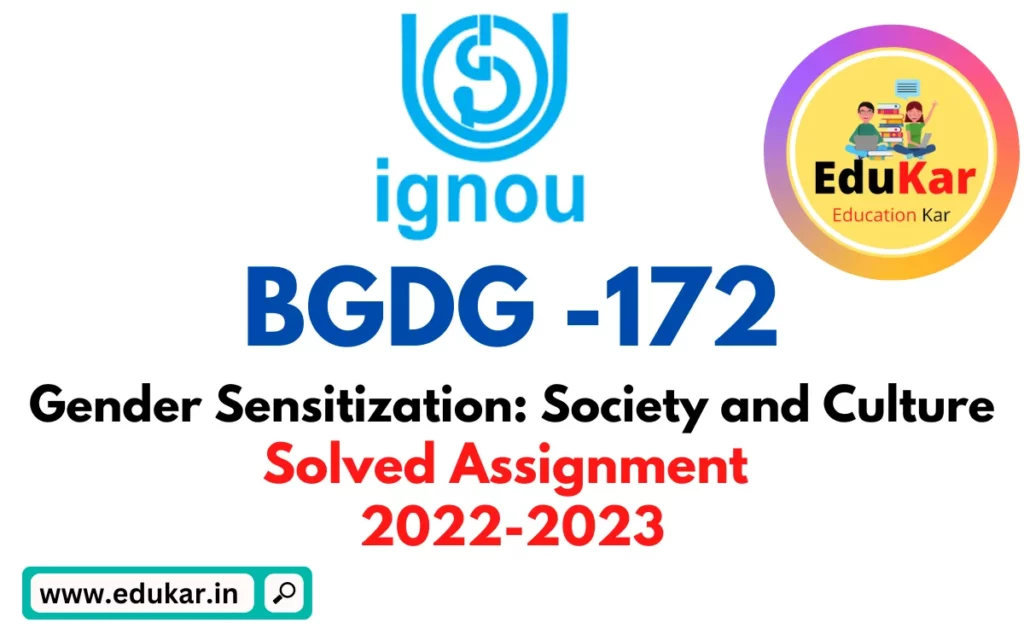Contents
- 1 Section A
- 2 Answer the following in about 500 words each.
- 3 1. Describe the terms masculinity and femininity in India? Do you think it shapes gender roles? Explain.
- 4 2. Describe the relationship of labour force participation, economy and gender question as a key focus. Support your argument by providing suitable examples.
- 5 Section B
- 6 Answer the following questions in about 250 words each.
- 7 3. Critically evaluate the role of the family from gender lens.
- 8 4. What is Sexual Harassment at Workplace. Examine its forms.
- 9 5. Write in your own words the ‘construction of a girl child’ with suitable examples.
- 10 Section C
- 11 Answer the following questions in about 100 words each.
- 12 6. Write a note on patriarchy.
- 13 7. What is radical feminism.
- 14 8. What are reproductive rights of Indian women?
- 15 9. Define productive and reproductive work.
- 16 10. What is mass media?

| Title | BGDG 172: IGNOU BAG Solved Assignment 2022-2023 |
| University | IGNOU |
| Degree | Bachelor Degree Programme |
| Course Code | BGDG-172 |
| Course Name | Gender Sensitization: Society and Culture |
| Programme Name | Bachelor of Arts (General) |
| Programme Code | BAG |
| Total Marks | 100 |
| Year | 2022-2023 |
| Language | English |
| Assignment Code | ASST /TMA / 2022-23 |
| Assignment PDF | Click Here |
| Last Date for Submission of Assignment: | For June Examination: 31st April For December Examination: 30th September |

Section A
Answer the following in about 500 words each.
1. Describe the terms masculinity and femininity in India? Do you think it shapes gender roles? Explain.
Ans: Masculinity and femininity are concepts that are deeply ingrained in Indian society and have a significant impact on gender roles. In India, masculinity is associated with traits such as strength, assertiveness, and dominance, while femininity is associated with traits such as nurturance, empathy, and submissiveness.
These gender roles are often reinforced by cultural and social norms that prescribe certain behaviors and expectations for men and women. For example, men are expected to be the primary breadwinners and protectors of their families, while women are expected to be homemakers and caregivers. These gender roles are deeply entrenched and have been passed down from generation to generation.
These gender roles are also reinforced by the media, which often portrays men as dominant and powerful, while women are portrayed as passive and submissive. The media often perpetuates the idea that women are only valuable for their physical beauty and their ability to please men. These messages are absorbed by both men and women and contribute to the perpetuation of gender stereotypes and gender-based discrimination.
The impact of masculinity and femininity on gender roles in India can be seen in a variety of contexts. For example, women often face discrimination in the workplace, where they are paid less than men for the same work and are less likely to be promoted to leadership positions. Women are also often subjected to sexual harassment and other forms of gender-based violence.
In addition, masculinity and femininity can also impact interpersonal relationships. Men are often socialized to be dominant and aggressive, which can lead to abusive behavior towards women. Women are often socialized to be passive and submissive, which can make it difficult for them to assert themselves and protect their own interests.
Overall, the concept of masculinity and femininity in India has a significant impact on gender roles and perpetuates gender-based discrimination. To address these issues, it is important to challenge and change the cultural and social norms that reinforce these gender roles. This can be done through education, media representation, and promoting gender equality and empowerment for both men and women.
2. Describe the relationship of labour force participation, economy and gender question as a key focus. Support your argument by providing suitable examples.
Ans: Labour force participation, economy, and gender are closely interconnected. The labour force participation rate measures the percentage of the working-age population (ages 15-64) who are employed or actively seeking employment. Gender has been identified as a significant factor affecting labour force participation rates, and these rates are linked to a country’s economic growth.
One of the reasons for the gender gap in labour force participation is due to traditional gender roles and societal expectations. Women are often expected to prioritize household and caregiving responsibilities over paid work. Additionally, in some countries, women may face legal or cultural barriers to employment, such as restrictions on working outside the home or limited access to education and training.
Low labour force participation rates among women can have negative economic consequences. A study by the McKinsey Global Institute estimated that if women participated in the labour force at the same rate as men, global GDP could increase by $28 trillion by 2025.
On the other hand, countries with higher rates of female labour force participation tend to have stronger economies. For example, countries such as Iceland, Norway, and Sweden have high rates of female labour force participation, and they also rank high in economic measures such as GDP per capita and the Human Development Index.
However, it’s not just about increasing women’s participation in the workforce. It’s also essential to address gender gaps in wages and job opportunities. Women are often overrepresented in low-paying, low-skilled jobs and underrepresented in high-paying, high-skilled occupations. For example, in the United States, women make up 48% of the workforce but earn only 81 cents for every dollar earned by men.
Efforts to promote gender equality in the labour force can take various forms, such as providing paid parental leave, promoting flexible work arrangements, and offering access to affordable childcare. For example, in 2018, Iceland became the first country in the world to require employers to prove that they pay men and women equally for the same job.
Section B
Answer the following questions in about 250 words each.
3. Critically evaluate the role of the family from gender lens.
Ans: The family is an essential social institution that plays a crucial role in shaping individuals and society as a whole. However, when examining the family from a gender lens, it becomes apparent that traditional family roles can reinforce gender inequality and limit opportunities for women.
One of the main ways in which the family reinforces gender inequality is through the division of labour. Women are often expected to perform unpaid care work, such as childcare and household chores, while men are expected to be the primary breadwinners. This division of labour perpetuates the idea that women’s work is less valuable than men’s work, and it can limit women’s opportunities for paid employment and economic independence.
Additionally, the family can reinforce gender norms and expectations that can be harmful to both men and women. For example, men are often socialized to be competitive, aggressive, and emotionally distant, while women are socialized to be nurturing, emotional, and subservient. These gendered expectations can lead to men feeling pressure to be the primary providers for their families, even if they would prefer to take on more caregiving responsibilities. Similarly, women may feel pressure to prioritize their family over their own career aspirations and personal goals.
However, it is important to note that the family can also be a site of resistance and change. Families can challenge traditional gender roles by sharing caregiving responsibilities and supporting each other’s career aspirations. Moreover, families can teach children to value gender equality and respect for diverse gender expressions.
4. What is Sexual Harassment at Workplace. Examine its forms.
Ans: Sexual harassment at the workplace is a form of sex discrimination that violates an individual’s fundamental rights, including their right to dignity, safety, and equality. It can take various forms and can occur in any industry, occupation, or workplace.
The most common forms of sexual harassment in the workplace include:
- Physical harassment – unwelcome physical contact or advances, such as touching, grabbing, or kissing, can be considered sexual harassment if it is not consensual.
- Verbal harassment – unwelcome sexual comments, jokes, or innuendos, which can be humiliating or offensive, can create a hostile work environment.
- Non-verbal harassment – leering, staring, or making sexual gestures or noises, can create an uncomfortable and intimidating work environment.
- Psychological harassment – unwelcome sexual advances, demands, or threats, can create a sense of fear or intimidation, which can negatively impact an individual’s mental and emotional well-being.
- Cyber harassment – sexual harassment can also occur through online communication, such as emails, text messages, or social media platforms, which can make it challenging to identify and address.
Sexual harassment can have significant and lasting effects on an individual’s physical, emotional, and mental health. It can also negatively impact their job performance and opportunities for career advancement. Therefore, it is crucial to address sexual harassment in the workplace and create a safe and inclusive environment for all employees.
5. Write in your own words the ‘construction of a girl child’ with suitable examples.
Ans: The construction of a girl child refers to the ways in which societal and cultural expectations shape the development of girls from birth. It involves the imposition of gender norms and stereotypes, which can have a significant impact on the self-concept, behavior, and opportunities of girls.
The construction of a girl child can be seen in a variety of ways. For example, girls are often socialized to be nurturing and empathetic, while boys are socialized to be aggressive and competitive. This can lead to girls being discouraged from pursuing careers in traditionally male-dominated fields, while boys are encouraged to do so.
The construction of a girl child is also seen in the ways in which girls are expected to present themselves physically. For example, girls are often expected to be thin and attractive, and they may face criticism and shaming if they do not meet these standards. This can lead to body image issues and a preoccupation with appearance.
Another example of the construction of a girl child can be seen in the way that girls are often taught to prioritize the needs and feelings of others over their own. This can lead to a lack of assertiveness and an inability to advocate for oneself, which can have long-term consequences for girls’ personal and professional lives.
Furthermore, the construction of a girl child can also be seen in the ways in which girls are treated in various cultures and societies around the world. For example, girls may be subjected to child marriage, female genital mutilation, or other forms of violence and discrimination simply because of their gender.
Section C
Answer the following questions in about 100 words each.
6. Write a note on patriarchy.
Ans: Patriarchy refers to a social system in which men hold primary power and dominate in roles of political leadership, moral authority, social privilege, and control of property. It is a system in which men are seen as superior to women and gender inequality is perpetuated. Patriarchy can be seen in many aspects of society, including family structure, the workplace, and politics. It can have a significant impact on women’s access to opportunities, resources, and decision-making power. The effects of patriarchy can be challenging to address, but it is essential to recognize its existence and work towards promoting gender equality and dismantling oppressive systems.
7. What is radical feminism.
Ans: Radical feminism is a feminist perspective that seeks to address the root causes of gender inequality, including the patriarchal social, political, and economic systems. It views gender as a fundamental category of analysis and advocates for the dismantling of traditional gender roles and the promotion of gender equality. Radical feminists argue that oppression against women is deeply ingrained in society, and that traditional liberal feminist approaches, such as seeking equality within existing power structures, are inadequate. They call for a fundamental reorganization of society that challenges the fundamental systems that perpetuate gender inequality.
8. What are reproductive rights of Indian women?
Ans: Reproductive rights of Indian women include the right to make decisions about their own bodies and reproductive health without coercion, discrimination, or violence. These rights include the right to access contraception, safe and legal abortion services, and comprehensive sexual education. Women also have the right to access maternal healthcare services, including skilled birth attendants and emergency obstetric care. Additionally, women have the right to be free from forced sterilization, forced pregnancy, and other forms of reproductive coercion. These reproductive rights are protected under Indian law, including the Medical Termination of Pregnancy Act and the Reproductive and Child Health Care Policy.
9. Define productive and reproductive work.
Ans: Productive work generally refers to any form of work that contributes to the production of goods or services that are sold in the market or generate income for the individual or organization. This can include activities such as manufacturing, farming, trading, or service provision.
Reproductive work, on the other hand, refers to any work that is related to the care, maintenance, and well-being of individuals, families, and communities. This can include activities such as cooking, cleaning, childcare, elder care, and emotional labor. Reproductive work is often unpaid or underpaid and is disproportionately performed by women, especially in developing countries. It is essential for the functioning of societies and economies but is often undervalued and invisible in economic and political discourse.
10. What is mass media?
Ans: Mass media refers to various channels of communication that reach large audiences, including television, radio, newspapers, magazines, and the internet. It is a tool for the dissemination of information, entertainment, and advertising on a large scale. The mass media has a significant impact on society, shaping public opinion, attitudes, and values. It can influence political and social movements, as well as consumer behavior. Mass media has become a pervasive force in modern society and has the power to both inform and shape public discourse.
How to Download BGDG-172 Solved Assignment?
You can download it from the www.edukar.in, they have a big database for all the IGNOU solved assignments.
Is the BGDG-172 Solved Assignment Free?
Yes this is absolutely free to download the solved assignment from www.edukar.in
What is the last submission date for BGDG-172 Solved Assignment?
For June Examination: 31st April, For December Examination: 30th October




![[Solved Assignment] BPCS 185-DEVELOPING EMOTIONAL COMPETENCE (IGNOU-BAG) 2022-2023 [Solved Assignment] BPCS 185-DEVELOPING EMOTIONAL COMPETENCE (IGNOU-BAG) 2022-2023](https://edukar.in/wp-content/plugins/contextual-related-posts/default.png)











